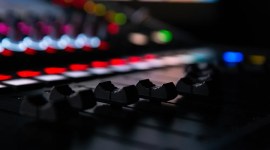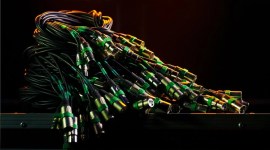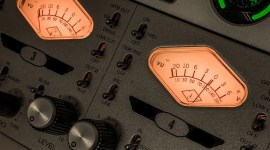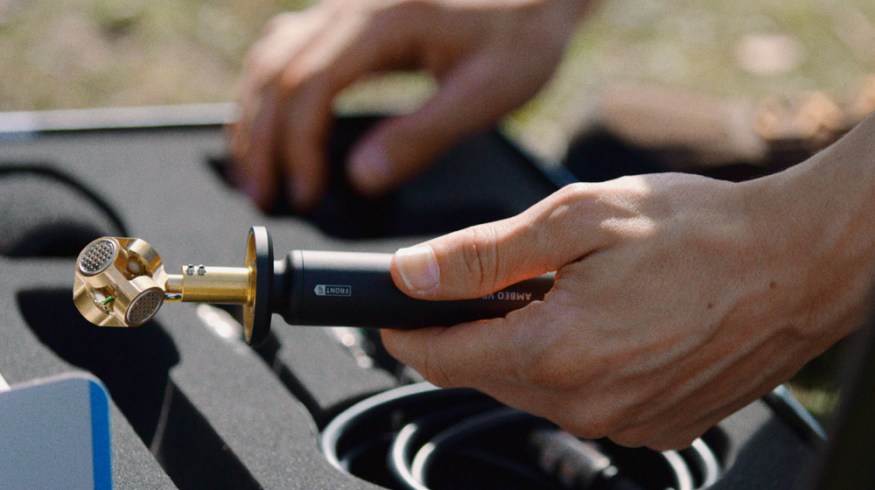
7 Unconventional Types of Microphones You Didn’t Know About
Ever hear a sound that is other worldly and wondered where it might have come from or how it was recorded? The answer is probably unconventional types of microphones.
We’re all familiar with standard microphones to record dialogue, vocals on a track, or ambient noise.
While these microphones may provide you with what you need, these other unconventional types of microphones can give that extra immersive sonic experience. Whether from recording vibrations from the surface of an object, underwater sounds, or three-dimensional audio, these microphones are specifically designed to capture certain extraordinary sounds.
1. Contact Microphones
A contact microphone works slightly differently from your usual microphone. These pick up vibrations through contact with objects rather than the sound waves through the air. Also known as Piezo mics or Transducer mics, these are used primarily to amplify acoustic instruments like a guitar.
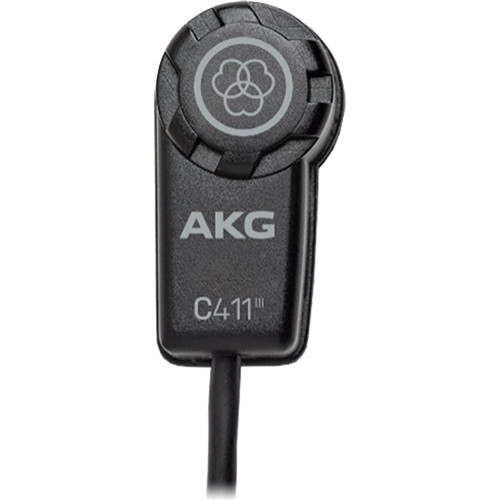
Additionally, these are great tools for sound artists who like to experiment with sound and a low-cost sound exploration. Contact microphones have relatively simple construction and minimal parts, so they are also easy to use. You can even make one yourself!
Objects such as metal gates, railings, pipes, and vehicles are significant for contact microphones. The portability of this piece of equipment makes it easy to capture an array of sounds. Objects that may produce a lot of reverb can create interesting sound textures, perfect for sci-fi or otherworldly sound effects.
Working with a contact microphone is a fun and creative way to go out and about, hit objects and find cool ways to make new sounds.
2. Hydrophones
A hydrophone is the contact mic’s sibling. Hydrophones collect sound vibrations from underwater. If you want a more immersive water sound, hydrophones will do the job. These are made the same way as a contact mic (based on a piezoelectric transducer) but with a waterproof coating.
The construction comprises certain ceramics that produce small electrical currents when the water pressure changes. When the hydrophone goes underwater, it reads electrical signals over a wide range of frequencies.
Here is a more technical definition provided by the Ocean Service. “By amplifying and recording these electrical signals, hydrophones measure ocean sounds with great precision. While a single hydrophone can record sounds from any direction, several hydrophones simultaneously positioned in an array, often thousands of miles apart, result in signals that can be manipulated to “listen” with greater sensitivity than a single device. Omni-directional and hemi-directional hydrophones pick up sound from a particular direction and can be used to track fish movements.”
Here’s an excellent video of a group of performers playing underwater instruments. The results are pretty incredible, and here they use hydrophones!
3. Binaural Microphones
We are now entering the world of three-dimensional sound, and first up is the Binaural Microphone.
Binaural audio is the method of recording using two microphones positioned so that it emulates human hearing. This hearing allows us humans and animals to locate a sound source. Fun fact: “Binaural” literally translates as “of two ears.”

The first binaural recording method used a dummy head with a microphone in each ear. The recording is best heard using headphones, as the binaural recording won’t translate correctly on a stereo field.
Conventional audio we hear every day, whether from a song or the sonic environment of a film, doesn’t take into account the natural ear spacing or head shadow. Binaural recording paints a three-dimensional soundscape inside your head! ASMR creators use binaural microphones for a more realistic and pleasurable experience for viewers.
Here is a famous video called Virtual Barber Shop. Wear some headphones for the whole experience…
Our ears, head, and brain have a relationship that’s quite amazing. All three of these combine to respond to an audible sound wave. From this, we can locate and identify its pitch and what source produced them.
When we consider the space between our ears, if the sound is coming from one side, it’ll naturally be louder on that side. This also affects how long it takes for the sound to travel to each ear. This is how the brain knows the location of the sound.
The best binaural recording device is the Neumann KU 100. This is a replica of a human head with anatomically accurate ears. It has two omnidirectional condenser capsules in each ear. They are low-noise and can withstand high sound pressure.
4. Ambisonic Microphones
Staying in the realms of three-dimensional audio, ambisonic microphone types refer to a full-sphere sound design. An ambisonic microphone picks up sound waves in full directivity, covering 360° of sonic space.

Ambisonics began as a scientific theory by Michael Gerzon, Peter Felgett, and Geoffrey Barton in the early 1970s. This, in turn, saw the first SoundField microphone released in 1978, as well as the A format and B format. These formats refer to the signals the microphones record.
The microphone consists of 4 capsules arranged in a tetrahedral arrangement. This allows coverage up, down, left, right, forwards, and backward. These types of microphones would be used for three-dimensional surround sound. If you need a field recording of ambient nature sounds, an ambisonic microphone will do the job.
For those creating Virtual Reality content, ambisonics microphones have you covered. As an ever-growing medium in game and video, capturing that 360° sound will create that ultra-realistic head-tracking sound experience.
Sound is a crucial feature when it comes to content creation; ambisonics have provided the option to position yourself in the sound field to transport you quite literally into that sonic environment.
There are some special software and plugin considerations to consider when working with Ambisonic Sound in post. Check this article for more details.
5. Electromagnetic Microphones
Let’s back away from immersive microphone experiences and ambisonics to even more unusual microphones. This is the electromagnetic microphone, which is probably one of the more unconventional microphones on this list.
This particular type of microphone uses an induction coil to pick up and convert electromagnetic fields into sound. It uses magnetic waves from anything that produces electric signals, such as microwave or a cell phone. They can capture the ambient sounds of ultrasonic noises and electromagnetic signals.
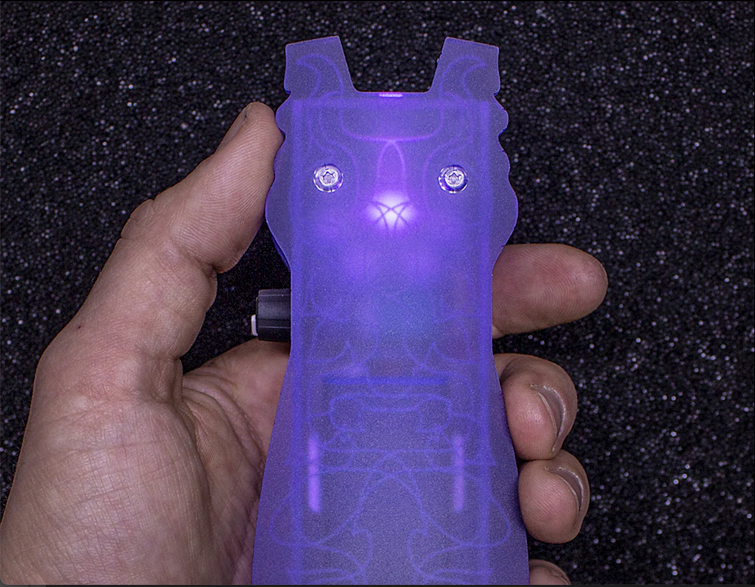
For those who are interested in these weird electronic hums and buzzes, this microphone is for you. Here’s a video of composer and musician Andrew Huang exploring this device.
6. Parabolic Microphones
One of the more unique-looking types of microphones on this list, a parabolic microphone collects and focuses onto a transducer, very similar to how a satellite dish does with radio waves.
When you electronically increase the amplification of a sound, you get a lot of noise. The parabolic dish reduces this and acts as a noise-free amplifier. These microphones are great for picking up bird calls, distant conversations or field audio in sports broadcasts. Just aim the microphone at the sound source you want to record and you are good to go!
This microphone type is very popular when it comes to recording sound at sporting events, its a good way to get more of that dialogue happening on the field. Parabolic Mics are also incredibly useful when recording nature sounds and animal calls.
The downside to these microphones is that they have a poor low-frequency response, resulting in a lower reproduction of sound. The parabolic dish is only able to capture wavelengths smaller than the dish itself. The bigger the dish, the further it can capture sound waves.
Heres a video explaining the functions of the parabolic dish.
7. Fibre Optic Microphones
These types of microphones are perfect for recording in more hostile environments. That is due to their robust structure.
Fibre Optic microphones record the variations of light intensity, turning them into acoustic signals. They are completely desensitized to outside interference from electrical, magnetic, and radioactive signals. This makes them ideal for industrial acoustic monitoring.
An example of using a fiber optic microphone in context is on rocket engines. Acoustic measurements need to be carried out on these ginormous machines, these microphones can withstand the extreme environments that they produce. These types of microphones are also metal-free so no electrical current can go through them, making them extra safe for those dangerous environments.
The medical field also uses fibre optic microphones. Inside an MRI suite, you will find these microphones. It allows patients and radiologists to have a normal conversation in a rather noisy magnetic environment, providing active noise canceling. While these aren’t really used in creative industry, I reckon there are some cool sounds heard from these mics!
So that’s a wrap on unconventional microphones. Which one of these would you like to try out? The world of sound is an ever-expanding field and devices like these are pioneering game changers in the creative scene.
For more on the world of audio check out these articles below!
- What is Audio Distortion?
- 4 Production Audio Tips from an Industry Insider
- The Most Practical Live-streaming Microphones on the Market
- Blind Microphone Comparison with 5 Different Mics!
Cover image via Lewis McGregor.


